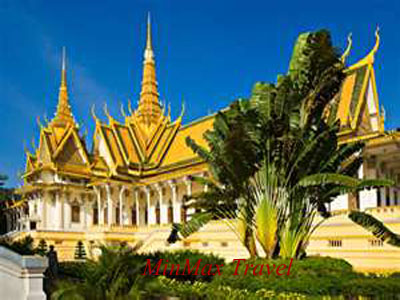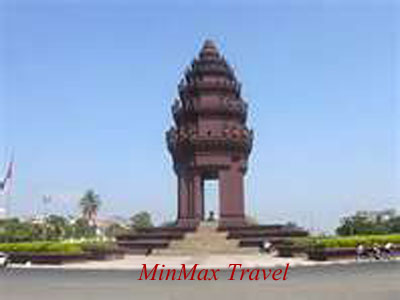Around Phnom Penh
There are several attractions around Phnom Penh that make good day trips out of the capital, although they are quite low key when compared with other parts of the country. The Angkorian temple of Tonle Bati and the hilltop pagoda of Phnom Chisor are best visited in one trip, and can be incorporated into a southward journey to either Takeo or Karnpot. Phnom Udong, once the capital of Cambodia, is also a pleasant day trip and can be combined with a visit to Kompong Chhnang, a 'genuine' Cambodian town.
There is now a clean, comfortable and cheap bus network operated by the Ho Wah Genting Bus Company covering most of the places in this chapter. Motorcycles are another interesting way to visit these attractions, as you can stop in small villages along the way. See the Phnom Penh chapter for details on motorbike rentals. If you value time above money, you can rent a taxi to whisk you around for between US$20 and US$30 a day.
Highlights
Tonle Bati is an Angkor - era temple without the Angkor tourists.
Udong was once Cambodia's royal capital and is the final resting place of many kings.
Phnom Da is an ancient hill temple set among lush paddy fields.
Phnom Chisor offers fantastic views across the Cambodian countryside
PHNOM UDONG
Udong ('the Victorious') served as the capital of Cambodia under several sovereigns between 1618 and 1866. A number of kings, including King Norodom, were crowned there. The main attractions these days are the row humps of Phnom Udong, which have several stupid on them. Both ends of the ridge have good views of the Cambodian countryside dotted with innumerable sugar palm trees. From Phnom Penh's taller buildings, weather permitting, the bluffs of Udong appear as two symmetrical hills - one of which is topped with spires - in the middle of the plains stretching northward from the city.
Udong is not a major attraction, but for those with the time it's worth seeing. It's generally very quiet, though picnickers tend to arrive from Phnom Penh on the weekends.
The smaller ridge has two structures - both heavily damaged - and several stupas on top. Ta San Mosque faces westward towards Mecca. Only the bullet and shrapnel-pocked walls survived the years of Khmer Rouge rule, though there are said to be plans to rebuild it. From the mosque you can see, across the plains to the south, Phnom Vihear Leu, a small hill on which a vihara (sanctuary) stands berween rwo white poles. To the right of the vihara is a building used as a prison under Pol Pot.  To the left of the vihara and below it is a pagoda known as Arey Ka Sap The larger ridge, Phnom Penh Reach Throap (Hill of the Royal Fortune), is so named because a 16th century Khmer king is said to have hidden the national treasury here during a war with the Thais.
To the left of the vihara and below it is a pagoda known as Arey Ka Sap The larger ridge, Phnom Penh Reach Throap (Hill of the Royal Fortune), is so named because a 16th century Khmer king is said to have hidden the national treasury here during a war with the Thais.
The most in pressive structure on Phnom Preah Reac Throap is Vihear Preah Ath Roes (Vihara ( the 18 Cubit Buddha). The vihara and Buddha, dedicated in 1911 by King Sisowatl were blown up by the Khmer Rouge in 1911 only sections of the walls, the bases of eight enormous columns and the right arm and partof the right side of the Buddha remain.
About 120m north-west of Vihear Preah Ath Roes is a line of small viharas. The first is Vihear Preah Ko, a brick-roofed structure that contains a statue of Preah Ko, the saered bull; the original of this statue was carried away by the Thais long ago. The second structure, which has a seated Buddha inside, is Vi hear Preah Keo. The third is Vihear Prak Neak, its cracked walls topped with a temporary thatch roof. Inside is a seated Buddha guarded by a naga, or mythical serpent (prak neak means 'protected by a naga').
At the north-west extremity of the ridge stand three large stupas. The first is the cement Chet Dey Mak Proum, the final resting place of King Monivong (ruled 1927 to 1941). Decorated with guards (half bird, half human), floral designs and elephants, it has four Bayon-style faces on top. The middle stupid, Tray Troeng, is decorated with colored tiles; it was built in 1891 by King Norodom for the ashes of his father, King Ang Duong (ruled 1845 to 1859). But some say King Ang Duong was buried next to the Silver Pagoda in Phnom Penh. The third stupa, Damrei Sam Poan, was built by King Chey Chethar II (ruled 1618 to 1626) for the ashes of his predecessor, King Soriyopor.
An eastward-oriented staircase leads down the hillside from the stupa of King Monivong. Just north of its base is a pavilion decorated with graphic murals depicting Khmer Rouge atrocities.
At the base of the ridge, close to the path, is a memorial to the victims of Pol Pot containing the bones of some of the people who were buried in approximately 100 mass graves, each containing about a dozen bodies. Instruments of torture were unearthed along with the bones when a number of the 2m by 2.5m pits were disinterred in 1981 and 1982.
Getting There & Away
Udong is 40km from the capital. To get there, head north out of Phnom Penh on National Hwy 5. Continue past Prek Kdam ferry for 4.5km and turn left (south) at the archway. Udong is 3.5km south of the turnoff; the access road goes through the village of Psar Dek Krom, and passes by a memorial to Pol Pot's victims and a structure known as the Blue Stupa, before arriving at a short staircase.
The cheapest and best way to get to Udong is by air-con local bus from Phnom Penh. Buses from near the Psar Thmei (New Market) run every 45 minutes throughout the day and cost 2000r. They drop you at the access road to Udong from where you can arrange a moto to the base of the hill for about 1500r. Buses also run the other way every 45 minutes. Buses to/from Kompong Chhnang also stop here, so you can combine your visit to the temples with a visit to a Cambodian town that sees few tourists.
A taxi to Phnom Udong and back will cost around US$20. It might be a good idea to hire the car for the day and include another destination such as Kompong Chhnang. The Capitol Guesthouse in Phnom Penh can arrange share taxis for US$5 per head for the return trip to Udong. Moto drivers also run people to Udong for about US$6 for the day, but when compared with the bus this isn't the most pleasant way to go.

